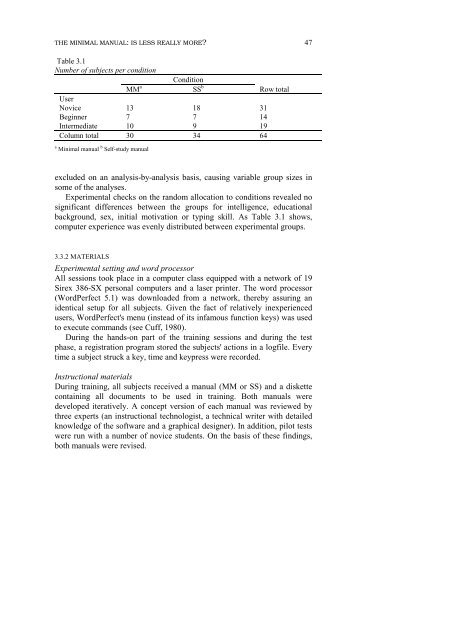MINIMALIST COMPUTER DOCUMENTATION - Universiteit Twente
MINIMALIST COMPUTER DOCUMENTATION - Universiteit Twente
MINIMALIST COMPUTER DOCUMENTATION - Universiteit Twente
Create successful ePaper yourself
Turn your PDF publications into a flip-book with our unique Google optimized e-Paper software.
THE MINIMAL MANUAL: IS LESS REALLY MORE?<br />
Table 3.1<br />
Number of subjects per condition<br />
MM<br />
Condition<br />
a SS b Row total<br />
User<br />
Novice<br />
Beginner<br />
Intermediate<br />
13<br />
7<br />
10<br />
18<br />
7<br />
9<br />
Column total 30 34 64<br />
a Minimal manual b Self-study manual<br />
excluded on an analysis-by-analysis basis, causing variable group sizes in<br />
some of the analyses.<br />
Experimental checks on the random allocation to conditions revealed no<br />
significant differences between the groups for intelligence, educational<br />
background, sex, initial motivation or typing skill. As Table 3.1 shows,<br />
computer experience was evenly distributed between experimental groups.<br />
3.3.2 MATERIALS<br />
Experimental setting and word processor<br />
All sessions took place in a computer class equipped with a network of 19<br />
Sirex 386-SX personal computers and a laser printer. The word processor<br />
(WordPerfect 5.1) was downloaded from a network, thereby assuring an<br />
identical setup for all subjects. Given the fact of relatively inexperienced<br />
users, WordPerfect's menu (instead of its infamous function keys) was used<br />
to execute commands (see Cuff, 1980).<br />
During the hands-on part of the training sessions and during the test<br />
phase, a registration program stored the subjects' actions in a logfile. Every<br />
time a subject struck a key, time and keypress were recorded.<br />
Instructional materials<br />
During training, all subjects received a manual (MM or SS) and a diskette<br />
containing all documents to be used in training. Both manuals were<br />
developed iteratively. A concept version of each manual was reviewed by<br />
three experts (an instructional technologist, a technical writer with detailed<br />
knowledge of the software and a graphical designer). In addition, pilot tests<br />
were run with a number of novice students. On the basis of these findings,<br />
both manuals were revised.<br />
31<br />
14<br />
19<br />
47
















